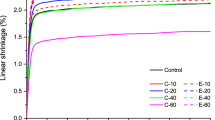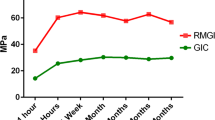Abstract
In order to model the processes that occur within polyacid-modified composite resin (“compomer”) dental restoratives, a series of experiments has been carried out with silanated and silane-free ionomer glass G338, and silanated and silane-free unreactive glass (Raysorb T-4000). In an acid-base reaction with dental grade aqueous maleic acid–acrylic acid copolymer solution, the setting time of the silanted G338 was found to be 9 min, compared with 5 min for the silane-free glass. Inclusion of each glass in an experimental composite resin system showed that the formulations which contained G338 absorbed more water than the formulations which contained Raysorb T-4000, regardless of whether or not the glass was silanted. Biaxial flexure strength was superior for experimental composites containing Raysorb T-4000, with highest results being obtained with the silanated glass. Overall these results demonstrate that silanation of the filler is essential for optimal physical properties but that, for the ionomer glass, it inhibits the acid-base reaction. The presence of ionomer glass led to an increase in water uptake compared with the unreactive glass, regardless of the presence of silane.
Similar content being viewed by others
References
J. W. MCLEAN, J. W. NICHOLSON and A. D. WILSON, Quintessence Int. 25 (1994) 587.
J. W. MEYER, M. A. CATTANI-LORENTE and V. DUPUIS, Biomaterials 19 (1998) 529.
J. W. NICHOLSON and M. AL SARHEED, J. Oral Rehabil. 25 (1998) 616.
G. ELIADES, A. KAKABOURA and G. PALAGHIAS, Dent. Mater. 14 (1998) 57.
R. M. H. VERBEECK, E. A. P. DE MAEYER, L. A. M. MARKS, R. J. G. DE MOOR, A. M. J. C. DE WITTE and L. M. TRIMPENEERS, Biomaterials 19 (1998) 509.
J. W. NICHOLSON, B. J. MILLAR, B. CZARNECKA and H. LIMANOWSKA-SHAW, Dent. Mater. 15 (1999) 413.
J. M. V. VAN DIJKEN, Amer. J. Dent. 9 (1996) 195.
R. J. CRISP and F. J. T. BURKE, Quintessence Int. 31 (2000) 181.
T. P. CROLL, ibid. 29 (1998) 697.
A. J. PRESTON and L. H. MAIR, J. Dent. Res. 75 (1996) 1177 (Abstract 368).
Y. LUO, E. C. M. LO, D. T. S. FANG, R. J. SMALES and S. H. Y. WEI, Am. J. Dent. 15 (2002) 403.
K. J. ANUSAVICE, “Phillips' Science of Dental Materials” (W. B. Saunders & Co, Philadelphia, 1996).
M. BRADEN and R. L. CLARKE, Biomaterials 5 (1984) 369.
S. C. BOVIS, E. HARRINGTON and H. J. WILSON, Brit. Dent. J. 131 (1971) 352.
A. D. WILSON and J. W. NICHOLSON, “Acid-Base Cements” (The University Press, Cambridge, 1993).
S. BAN and K. J. ANUSAVICE, J. Dent. Res. 69 (1992) 1791.
D. K. SHETTY, A. R. ROSENFIELD, W. H. DUCKWORTH and P. R. HELD, J. Amer. Ceram. Soc. 66 (1983) 36.
R. CRAIG, “Restorative Dental Materials”, 8th edition (C.V. Mosby Co, Philadelphia, 1989).
S. CRISP, B. G. LEWIS and A. D. WILSON, J. Dent. 4 (1976) 287.
S. CRISP, B. G. LEWIS and A. D. WILSON, ibid. 5 (1977) 51.
Author information
Authors and Affiliations
Corresponding author
Rights and permissions
About this article
Cite this article
Adusei, G.O., Deb, S. & Nicholson, J.W. The role of the ionomer glass component in polyacid-modified composite resin dental restorative materials. Journal of Materials Science: Materials in Medicine 15, 751–754 (2004). https://doi.org/10.1023/B:JMSM.0000032813.18909.1b
Issue Date:
DOI: https://doi.org/10.1023/B:JMSM.0000032813.18909.1b




